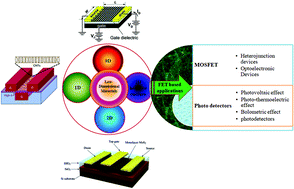Evolution of low-dimensional material-based field-effect transistors
Abstract
Field-effect transistors (FETs) have tremendous applications in the electronics industry due to their outstanding features such as small size, easy fabrication, compatibility with integrated electronics, high sensitivity, rapid detection and easy measuring procedures. However, to meet the increasing demand of the electronics industry, efficient FETs with controlled short channel effects, enhanced surface stability, reduced size, and superior performances based on low-dimensional materials are desirable. In this review, we present the developmental roadmap of FETs from conventional to miniaturized devices and highlight their prospective applications in the field of optoelectronic devices. Initially, a detailed study of the general importance of bulk and low-dimensional materials is presented. Then, recent advances in low-dimensional material heterostructures, classification of FETs, and the applications of low-dimensional materials in field-effect transistors and photodetectors are presented in detail. In addition, we also describe current issues in low-dimensional material-based FETs and propose potential approaches to address these issues, which are crucial for developing electronic and optoelectronic devices. This review will provide guidelines for low-dimensional material-based FETs with high performance and advanced applications in the future.

- This article is part of the themed collection: Recent Review Articles


 Please wait while we load your content...
Please wait while we load your content...